Introduction
In 2011 the UK had 6,444 registered fishing vessels, 17 per cent fewer than in 2001. Over the
same period, the number of fishermen on UK registered vessels has fallen by almost 2,600 to
12,400. The number of days spent at sea by vessels over 10 metres in length has fallen by 42 per
cent.
This release brings together information on:
- Size and composition of the UK fishing fleet
- Number of fishermen on UK registered fishing vessels
- Accidents involving fishing vessels and fishermen
- Fishing effort by UK vessels, including expanded coverage of effort in the cod and sole recovery zones and the Western Waters
All tables presented here are available to download as spreadsheets from the MMO website. Supplementary tables showing more detail can also be found on the website.
The EU Fishing Fleet
In 2011, the highest number of fishing vessels in the European Union was in Greece (16,663) while the UK was sixth with 6,444 (see Chart 1). Spains capacity (399 thousand GT) is by far the largest, being almost double that of second place UK with 202 thousand GT. The UK has the fourth most powerful fleet (0.81 million kW) behind Italy (1.06 million kW), France (1.00 million kW) and Spain (0.90 million kW).
Size of the EU Fishing Fleet by Member State: 2011
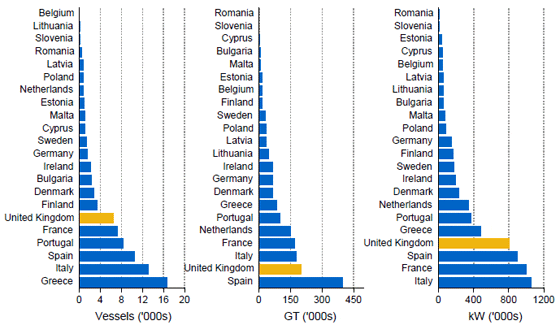
Note: Data for Chart 1 are available for download from the MMO website as supplementary Table 12.
The UK fishing fleet
The number of registered UK fishing vessels has fallen by 26 per cent since 1996. Capacity (GT) and power (kW) have decreased by 26 per cent and 23 per cent respectively over the same period (see Table 1). As well as an underlying downwards trend in the size of the fleet associated with reduced fishing opportunities, UK fisheries administrations have operated decommissioning exercises in 2001-2002, 2003, 2007 and 2008-2009. The decommissioning exercises aimed to withdraw some capacity and effort from UK fisheries to help ensure a sustainable future, and to allow vessel owners to take a business decision on whether to remain in the fishery under the terms of fishery management plans.
Size of the UK Fishing Fleet: 1996 to 2011(a)
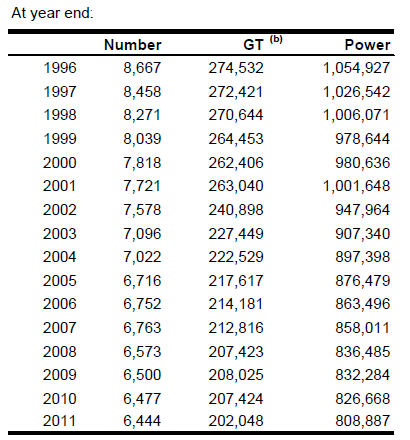
Source: Maritime and Coastguard Agency and Fisheries Administrations in the UK
(a) Includes Channel Islands, the Isle of Man and vessels without an administration port. Excludes mussel dredgers.
(b) The series for GT is on the basis of GT at the end of 2003.
The UK Fishing Fleet by Country
Size of the UK Fishing Fleet by Country: 2011
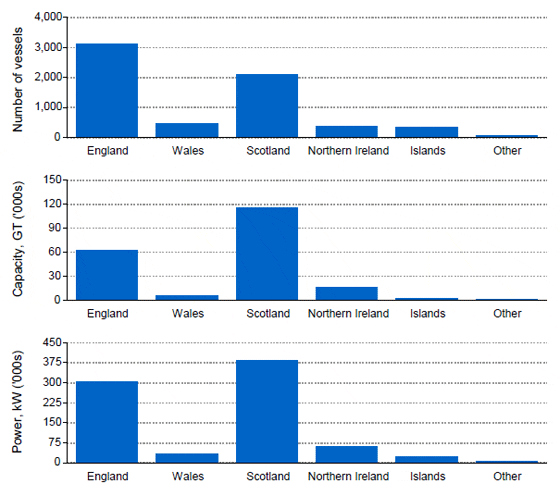
England has the largest number of vessels, accounting for 48 per cent of the total UK fleet with
Scottish vessels making up 32 per cent of the UK fleet. However, Scotland has the highest share
of capacity (GT), 57 per cent, and power (kW), 47 per cent, compared with 31 per cent and 38 per
cent respectively in England.
To understand why England has a larger number of vessels than Scotland and yet has a smaller
share of capacity and power requires a more detailed analysis of the fleet composition based on
vessel length (see Table 3). This difference can partly be explained by the higher proportion of
vessels of 10 metres and under in length in the English fleet 82 per cent in England compared
with 70 per cent in Scotland.
Percentage of Vessels in the 10m and Under and Over 10m Sectors by Country: 2011
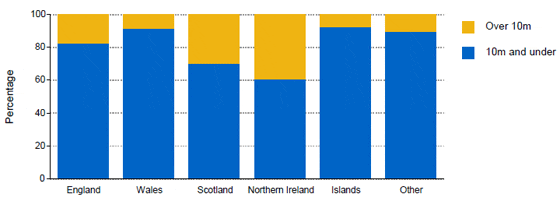
The overlapping areas of interest of the fleets make it difficult to provide a simple explanation of the
differences in fleet structure across the UK. One relevant factor is the different fishing opportunities
the fleets are engaged in. Key elements of the Scottish fleet are engaged in several fisheries that
are high volume but lower priced. This includes fisheries such as the herring and mackerel
fisheries in the North Sea and West of Scotland waters. As such the Scottish fleet has moved
towards having higher capacity vessels that can take part in these fisheries that can cover large
sea areas and involve catching several hundred tonnes of fish per vessel in order to be
economically viable.
Compared with this, the English fleet is involved in several key fisheries that are typically lower
volume but higher priced, such as the Channel fisheries for sole and plaice. In addition, a greater
proportion of the fisheries the English fleet is engaged in cover inshore areas. Together these
factors have allowed the English fleet to develop with a greater proportion of smaller vessels that
are able to be economically viable through catching smaller quantities of more valuable fish.
Changes over time in the nature of fishing opportunities available to the different elements of the
UK fleet have also been key drivers for the development of the fleet.
Table 2 shows the number, capacity (GT) and power (kW) of registered UK fishing vessels by
vessel nationality and sector, i.e. over 10 metres and 10 metres and under in length.
The UK Fishing Fleet by Length
Almost four fifths of the UK fleet is made up of vessels of 10 metres and under in length. These
vessels account for 9 per cent of the fleets capacity and a third of the fleets power. However,
vessels over 18 metres in length account for just 8 per cent of the total number but for 79 per cent
of total capacity and 48 per cent of total power.
Table 3 shows the number, capacity (GT) and power (kW) of registered UK fishing vessels by
vessel nationality and vessel length.
Scotland and Northern Ireland have higher proportions of large vessels than England. For
example, 18 per cent of the Scottish fleet and 29 per cent of the far smaller Northern Irish fleet
exceed 15 metres in length compared with 6 per cent in England. However, the number of Scottish
vessels exceeding 15 metres in length fell by 8 per cent in 2011. The capacity of the 274 vessels
over 18 metres in length in Scotland is almost the same as the total capacity of the English, Welsh
and Northern Irish fleet combined.
The UK Fishing Fleet by Administration Port
Charts 5 to 7 show the fleet size by number of vessels, capacity (GT) and power (kW) for each
administration port in the UK. Each chart shows the relative size of the fleet broken down into the
over 10 metres and 10 metres and under sectors.
In 2011:
- Newlyn had the largest number (622) of vessels in its administration. 88 per cent of these were of 10 metres and under overall length.
- The fleet administered by Fraserburgh had by far the largest capacity (35,100 GT) and power (96,400 kW).
- The largest proportion of 10 metre and under vessels was in Hastings (93 per cent). Administration ports in Wales and the south and west coast of England also had large proportions of 10 metre and under vessels.
The UK Fishing Fleet by Age
In total, 62 per cent of the UK fleet (whose age is known) were built more than twenty years ago. While the number of vessels being built since 1991 has decreased, the average capacity and power of these vessels has increased by 50 per cent (see Chart 8).
Membership of Fish Producer Organisations
On 31 December 2011, 35 per cent of vessels over 10 metres in length were not members of a Fish Producer Organisation (FPO). The Scottish FPO had the highest membership (195 vessels), followed by Northern Ireland FPO (112 vessels).
Fish Producer Organisation (FPO) Membership(a): 2010 to 2011
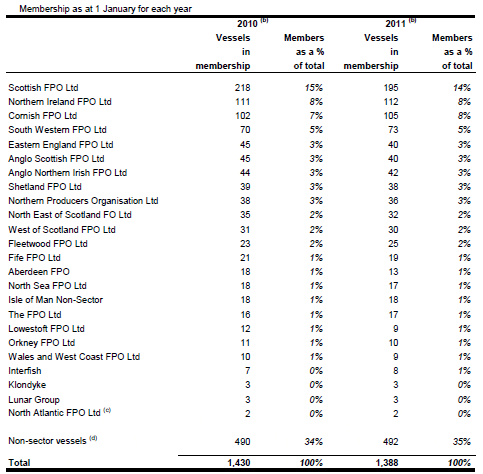
Source: Fisheries Administrations in the UK
(a) Vessels over 10 metres only. Excludes vessels 10 metres and under in FPO membership.
(b) Includes some Channel Islands and Isle of Man vessels.
(c) North Atlantic FPO Ltd was created in 2010
(d) Over 10m vessels not in FPO membership.
Number of Fishermen
Statistics on the number of fishermen are drawn from surveys carried out by the Marine
Management Organisation in England, the Welsh Assembly Government, the Department of
Agriculture and Rural Development in Northern Ireland and Marine Scotland. Details of the survey
methodology are provided in Appendix 3.
The number of fishermen on UK registered vessels has decreased by 17 per cent since 2001 from
around 15,000 to 12,400. The number of regular fishermen has decreased by 17 per cent and part-time
fishermen by 16 per cent over this period (see Chart 9). The decrease in fishermen numbers
may be associated with reductions in fleet size as well as decreased fishing opportunities.
Since 2001, the number of fishermen on English administered vessels has decreased by 13 per
cent and on vessels administered in Scotland by 25 per cent. In Northern Ireland fishermen
numbers increased by 23 per cent but they decreased in Wales by 11 per cent.
In 2011, part-time fishermen accounted for 19 per cent of all fishermen and no change from the
proportion in 2001. 30 per cent of fishermen on vessels administered in Wales were part-time
compared with 19 per cent for vessels administered in England, 18 per cent in Scotland and 16 per
cent in Northern Ireland.
Table 6 shows a breakdown of the number of regular and part-time fishermen by country in the UK
from 1938 to 2011. Since 1938:
- Numbers of fishermen on UK registered vessels have decreased by 74 per cent. This reduction has been experienced by both regular and part-time fishermen.
- The proportion of fishermen in each country of administration has changed little. In 1938 fishermen numbers in England and Wales represented 61 per cent of the UK total, while Scotland represented 37 per cent. In 2011, the proportions were 55 per cent and 40 per cent respectively.
Chart 12 shows the total number of fishermen for each administration port in the UK. In 2011:
- Milford Haven is the administration port with the largest number of fishermen in the UK (991). 38 per cent of fishermen on 10 metre and under vessels are part-time.
- Newlyn is the administration port with the largest number of fishermen in England (872). This is in part due to the large number of vessels of 9 metres and under overall length which are manned by part-time fishermen. 52 per cent of fishermen on 9 metre and under vessels are part-time.
- Fraserburgh has the largest number of fishermen in Scotland (788); however, the largest number of part-time fishermen is found on vessels administered by Shetland (197).
- Ports with higher numbers of vessels have higher numbers of fishermen. The three UK ports with the largest numbers of vessels (Newlyn, Poole and Milford Haven) are also the ports with most fishermen.
- Ports in Wales and the south and west coast of England have some of the lowest proportions of over 10 metre vessels and the greatest proportions of part-time fishermen.
- Ports with greater total vessel power tend to have a higher number of fishermen.
Accidents, Lost Vessels and Fatalities
Figures on accidents involving fishing vessels and fishermen are provided by the Marine Accident Investigation Branch, part of the Department for Transport.
UK Over 10m Fishing Fleet Effort
Since 2001, fishing effort (in kW days) by the over 10 metre fleet has decreased by 46 per cent.
(Chart 13). This reduction is primarily due to a decline in effort in the demersal trawl and seine
segment of 50 per cent (Chart 14). Falls in effort over this period were recorded for all other gear
types except those using dredges, pots and traps and some polyvalent gears.
This reduction in effort in the demersal trawl and seine segment was largely due to
decommissioning exercises carried out by UK fisheries administrations in 2001-2002 and 2003.
The latter focussed on removing fleet capacity targeting cod in the Cod Recovery Zone (a
combination of North Sea, West of Scotland and Irish Sea fishing areas), and was particularly
focussed on vessels that used demersal trawls fishing for whitefish. A further exercise was carried
out to remove excess beam trawl fishing capacity in the Western Channel fishing area (ICES
division VIIe), as part of the recovery regime for sole. This removed 8 active vessels in this area.
Effort of Vessels Fishing in the Sole Recovery Zone (SRZ)
As part of the measures for recovery of sole stocks, a sole recovery zone was established from
February 2004 to apply effort controls to vessels of 10 metres or over using certain gears in the
Western Channel (ICES division VIIe). The regimes which applied in 2010 are described in Annex
IIC of Council Regulations (EC) Nos 43/2009 and 53/2010.
Limits apply on the number of days spent at sea by vessels fishing with beam trawls of mesh size
greater than or equal to 80mm and by vessels using static nets (including gill nets, trammel nets
and tangle nets) with mesh size less than 220mm. The Marine Management Organisation controls
effort in the Western Channel by allocating days for fishing with these gears to eligible vessels.
From 2001 to 2004 the number of vessels beam trawling in the Western Channel decreased by 13
per cent; however, fishing effort (kW days) increased by 4 per cent. Since the implementation of
the SRZ, the number of vessels beam trawling in the Western Channel has decreased by 33 per
cent and effort (kW days) has decreased by 27 per cent (Chart 15). Reasons for this may include
the effect of decommissioning schemes as well as reduced fishing opportunities owing to effort and
quota controls.
Effort of Vessels Fishing in the Cod Recovery Zone (CRZ)
As part of the measures for recovery of cod stocks, a cod recovery zone was established from
February 2003 to apply effort controls to vessels of 10 metres or over using specified gears in the
North Sea and West of Scotland. The regime was expanded in 2004 to include the Irish Sea (ICES
division VIIa) and the Eastern Channel (ICES division VIId).
The regime in operation during 2011 was established by Council Regulation (EC) No 1342/2008.
The CRZ currently includes four sea areas: Kattegat, Irish Sea (ICES division VIIa), North Sea
(ICES division IIIa excluding Kattegat; ICES sub-area IV; EU waters of ICES division IIa; ICES
division VIId) and West of Scotland (ICES division VIa and EU waters of ICES division Vb). Eight
regulated gears are defined. UK Fisheries Administrations operate schemes to limit the number of
days spent fishing with these gears in each sea area.
Numbers of vessels fishing with regulated gears in each area of the CRZ are presented in Table 9,
together with the effort exerted by these vessels. For clarity, the figures are presented for calendar
years although annual controls cover a twelve month period from 1 February to 31 January. Effort
by vessels exempt from controls on the basis of low cod catches is included in these figures.
Trends for the two most cod-intensive gear groupings, TR1 and TR2, are discussed below.
Gear Type TR1
Gear type TR1 includes bottom trawls, Danish seines and similar towed gear, excluding beam
trawls, of mesh size greater than or equal to 100 mm. Gears of this type are typically used to target
whitefish, including cod.
From 2001 to the end of 2003 the number of vessels fishing in the CRZ using gear type TR1 fell by
25 per cent (Chart 16). Over the same period, effort (kW days) decreased by 41 per cent, in part
due to decommissioning schemes targeting the demersal fleet. Since the implementation of the
CRZ, the number of vessels using gear type TR1 has decreased by 60 per cent and effort (kW
days) by 47 per cent.
Gear Type TR2
Gear type TR2 includes bottom trawls, Danish seines and similar towed gear, excluding beam
trawls, of mesh size greater than or equal to 70 mm and less than 100 mm. Gears of this type are
typically used to target prawns (Nephrops), but may also catch significant amounts of cod.
From 2001 to the end of 2003 the number of vessels fishing in the CRZ using gear type TR2
decreased by 2 per cent while effort (kW days) increased by 37 per cent. Since the implementation
of the CRZ, the number of vessels using gear type TR2 has decreased by 31 per cent and effort
(kW days) decreased by 26 per cent.
Effort of Vessels Fishing in the Western Waters
To prevent growth in fishing activity in the sea areas to the west of the UK, Ireland, Spain, Portugal
and Morocco an area (the Western Waters) was established from November 2003 in which fishing
effort is limited. The regime was established by Council Regulation (EC) No 1954/2003 and
remains in force.
The Western Waters cover nine sea areas. Regulated activity is permitted for UK registered
vessels in only four of these. Ceilings exist on the maximum fishing effort to be exerted by 15
metres and over vessels targeting certain species in ICES sub-areas V and VI; ICES sub-area VII;
and ICES sub-area VIII. The fourth area is a region to the south and west of Ireland with high
concentrations of juvenile hake known as the Biologically Sensitive Area (BSA). Ceilings in this
region apply to fishing effort exerted by 10 metres and over vessels. Fisheries administrations
currently do not operate schemes to allocate days fishing in the Western Waters to eligible vessels.
Fishing trips where crabs, demersal species or scallops are targeted are all covered by the
regulation. The numbers of vessels on regulated trips in the above four areas of the Western
Waters are given in Table 10, together with the effort exerted by these vessels. Additional
information is given below for the two sea areas bordering the UK: ICES sub-areas V and VI, and
ICES sub-area VII.
The information included in this section is collated using the methodology required for the
submission of data returns to the Commission under the Western Waters regime. Within this
reporting regime, the UK and other Member States are required to submit monthly reports on
fishing effort. It is important to note that there is an early submission date for end-year data
(namely 15 January of the following year) with no set opportunity for further revisions after this
date. This requirement is due to the need of the Commission to finalise the datasets and assess
each Member States uptake of effort and quota, in order for it to put in place the required system
of penalties and other factors that impact on the current years levels of activity and quota.
However, it is recognised that while Member States work to ensure that a complete and verified set
of information is reported to the Commission at that time, there are several factors that create lags
in the availability of fully processed and verified data. This means that data on fishing effort and
fish landings continue to be received after the Commission deadline. More information on the
reasons for these delays is in appendix 3.
The information included here and in the associated tables available for download from the MMO
website is intended to provide as accurate a picture as possible of fishing activity carried out by the
UK fleet. As such it includes all data received after the Commissions deadline. This can lead to
differences when comparing the levels of uptake recorded on EU monitoring systems for both
fishing effort and quota uptake.
It is expected that the introduction of requirements on larger fishing vessels to report data
electronically will significantly reduce the time it takes fisheries administrations to receive data and
the time taken to enter the complex data returns. This is particularly true for the Western Waters
regime, which primarily relates to activity by UK vessels 15 metres and over in length, all of which
are now required to submit activity data electronically. However, there will still be delays related to
the need to check and verify the information reported before it is used in official reports on activity
by the UK fishing fleet.
Trips Targeting Crabs
Trips targeting edible crabs and spider crabs are covered by the Western Waters regime. From 2001 to 2011 the number of vessels targeting crabs in ICES sub-areas V and VI has fallen from 15 to 11 while the number in ICES sub-area VII has fluctuated from 23 vessels in 2001 to 14 vessels in 2011. Effort levels have fluctuated over this period and were 25 per cent higher for ICES subareas V and VI and were 4 per cent higher for ICES sub-area VII.
Trips Targeting Demersal Species
The Western Waters regime places limits on the effort exerted on trips targeting demersal species
excluding certain deep sea species.
From 2001 to 2011 the number of vessels targeting demersal species in ICES sub-areas V and VI
decreased by 47 per cent while the number in ICES sub-area VII fell by 38 per cent. The fall may
be partly attributed to decommissioning schemes and limited fishing opportunities due to effort and
quota controls. A corresponding decrease in effort occurred over the same period, with falls of 38
per cent and 20 per cent respectively in ICES sub-areas V and VI and ICES sub-area VII.
Trips Targeting Scallops
From 2001 to 2011 the number of vessels targeting scallops in ICES sub-areas V and VI decreased by 40 per cent. The number in ICES sub-area VII declined but has now more or less returned to the same level. Effort in ICES sub-areas V and VI fell by 55 per cent, but effort in ICES sub-area VII increased by 47 per cent. This increase is partly due to diversion of activity from other sea areas as well as increased activity by vessels already fishing in ICES sub-area VII.
August 2012
Further ReadingYou can view the full report with all graphs and tables by clicking here. |



